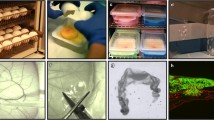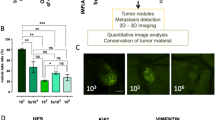Abstract
Cancer cell 'invasiveness' is one of the main driving forces in cancer metastasis, and assays that quantify this key attribute of cancer cells are crucial in cancer metastasis research. The research goal of many laboratories is to elucidate the signaling pathways and effectors that are responsible for cancer cell invasion, but many of these experiments rely on in vitro methods that do not specifically simulate individual steps of the metastatic cascade. Cancer cell extravasation is arguably the most important example of invasion in the metastatic cascade, whereby a single cancer cell undergoes transendothelial migration, forming invasive processes known as invadopodia to mediate translocation of the tumor cell from the vessel lumen into tissue in vivo. We have developed a rapid, reproducible and economical technique to evaluate cancer cell invasiveness by quantifying in vivo rates of cancer cell extravasation in the chorioallantoic membrane (CAM) of chicken embryos. This technique enables the investigator to perform well-powered loss-of-function studies of cancer cell extravasation within 24 h, and it can be used to identify and validate drugs with potential antimetastatic effects that specifically target cancer cell extravasation. A key advantage of this technique over similar assays is that intravascular cancer cells within the capillary bed of the CAM are clearly distinct from extravasated cells, which makes cancer cell extravasation easy to detect. An intermediate level of experience in injections of the chorioallantoic membrane of avian embryos and cell culture techniques is required to carry out the protocol.
This is a preview of subscription content, access via your institution
Access options
Subscribe to this journal
Receive 12 print issues and online access
$259.00 per year
only $21.58 per issue
Buy this article
- Purchase on Springer Link
- Instant access to full article PDF
Prices may be subject to local taxes which are calculated during checkout





Similar content being viewed by others
References
Chambers, A.F., Groom, A.C. & MacDonald, I.C. Dissemination and growth of cancer cells in metastatic sites. Nat. Rev. Cancer 2, 563–572 (2002).
Giampieri, S. et al. Localized and reversible TGFbeta signalling switches breast cancer cells from cohesive to single cell motility. Nat. Cell Biol. 11, 1287–1296 (2009).
Wyckoff, J.B., Jones, J.G., Condeelis, J.S. & Segall, J.E. A critical step in metastasis: in vivo analysis of intravasation at the primary tumor. Cancer Res. 60, 2504–2511 (2000).
Zijlstra, A., Lewis, J., Degryse, B., Stuhlmann, H. & Quigley, J.P. The inhibition of tumor cell intravasation and subsequent metastasis via regulation of in vivo tumor cell motility by the tetraspanin CD151. Cancer Cell 13, 221–234 (2008).
He, W., Wang, H., Hartmann, L.C., Cheng, J.-X. & Low, P.S. In vivo quantitation of rare circulating tumor cells by multiphoton intravital flow cytometry. Proc. Natl. Acad. Sci. USA 104, 11760–11765 (2007).
Menen, R.S. et al. A rapid imageable in vivo metastasis assay for circulating tumor cells. Anticancer Res. 31, 3125–3128 (2011).
Patsialou, A. et al. Intravital multiphoton imaging reveals multicellular streaming as a crucial component of in vivo cell migration in human breast tumors. Intravital 2, e25294 (2013).
Stoletov, K. et al. Visualizing extravasation dynamics of metastatic tumor cells. J. Cell Sci. 123, 2332–2341 (2010).
Leong, H.S. et al. Invadopodia are required for cancer cell extravasation and are a therapeutic target for metastasis. Cell Rep. 8, 1558–1570 (2014).
Barkan, D., Green, J.E. & Chambers, A.F. Extracellular matrix: a gatekeeper in the transition from dormancy to metastatic growth. Eur. J. Cancer 46, 1181–1188 (2010).
Barkan, D. et al. Inhibition of metastatic outgrowth from single dormant tumor cells by targeting the cytoskeleton. Cancer Res. 68, 6241–6250 (2008).
Rondeau, G. et al. Effects of different tissue microenvironments on gene expression in breast cancer cells. PLoS One 9, e101160 (2014).
Bartkowiak, K., Riethdorf, S. & Pantel, K. The interrelating dynamics of hypoxic tumor microenvironments and cancer cell phenotypes in cancer metastasis. Cancer Microenviron. 5, 59–72 (2012).
Cameron, M.D. et al. Temporal progression of metastasis in lung: cell survival, dormancy, and location dependence of metastatic inefficiency. Cancer Res. 60, 2541–2546 (2000).
Paku, S., Döme, B., Tóth, R. & Timár, J. Organ-specificity of the extravasation process: an ultrastructural study. Clin. Exp. Metastasis 18, 481–492 (2000).
Luzzi, K.J. et al. Multistep nature of metastatic inefficiency: dormancy of solitary cells after successful extravasation and limited survival of early micrometastases. Am. J. Pathol. 153, 865–873 (1998).
Schlüter, K. et al. Organ-specific metastatic tumor cell adhesion and extravasation of colon carcinoma cells with different metastatic potential. Am. J. Pathol. 169, 1064–1073 (2006).
Arpaia, E. et al. The interaction between caveolin-1 and Rho-GTPases promotes metastasis by controlling the expression of alpha5-integrin and the activation of Src, Ras and Erk. Oncogene 31, 884–896 (2012).
MacMillan, C.D. et al. Stage of breast cancer progression influences cellular response to activation of the WNT/planar cell polarity pathway. Sci. Rep. 4, 6315 (2014).
Cvetkovic, D. et al. KISS1R induces invasiveness of estrogen receptor-negative human mammary epithelial and breast cancer cells. Endocrinology 154, 1999–2014 (2013).
Veiseh, M. et al. Cellular heterogeneity profiling by hyaluronan probes reveals an invasive but slow-growing breast tumor subset. Proc. Natl. Acad. Sci. USA 111, E1731–E1739 (2014).
Rytelewski, M. et al. BRCA2 inhibition enhances cisplatin-mediated alterations in tumor cell proliferation, metabolism, and metastasis. Mol. Oncol. 8, 1429–1440 (2014).
Weiss, L., Mayhew, E., Rapp, D.G. & Holmes, J.C. Metastatic inefficiency in mice bearing B16 melanomas. Br. J. Cancer 45, 44–53 (1982).
Morris, V.L. et al. Mammary carcinoma cell lines of high and low metastatic potential differ not in extravasation but in subsequent migration and growth. Clin. Exp. Metastasis 12, 357–367 (1994).
Hill, R.P., Chambers, A.F., Ling, V. & Harris, J.F. Dynamic heterogeneity: rapid generation of metastatic variants in mouse B16 melanoma cells. Science 224, 998–1001 (1984).
Ebos, J.M.L. et al. Accelerated metastasis after short-term treatment with a potent inhibitor of tumor angiogenesis. Cancer Cell 15, 232–239 (2009).
Pàez-Ribes, M. et al. Antiangiogenic therapy elicits malignant progression of tumors to increased local invasion and distant metastasis. Cancer Cell 15, 220–231 (2009).
Eckert, M.A. et al. Twist1-induced invadopodia formation promotes tumor metastasis. Cancer Cell 19, 372–386 (2011).
Artym, V.V., Zhang, Y., Seillier-Moiseiwitsch, F., Yamada, K.M. & Mueller, S.C. Dynamic interactions of cortactin and membrane type 1 matrix metalloproteinase at invadopodia: defining the stages of invadopodia formation and function. Cancer Res. 66, 3034–3043 (2006).
Albini, A. & Benelli, R. The chemoinvasion assay: a method to assess tumor and endothelial cell invasion and its modulation. Nat. Protoc. 2, 504–511 (2007).
Albini, A. & Noonan, D.M. The 'chemoinvasion' assay, 25 years and still going strong: the use of reconstituted basement membranes to study cell invasion and angiogenesis. Curr. Opin. Cell Biol. 22, 677–689 (2010).
Reymond, N., Riou, P. & Ridley, A.J. Rho GTPases and cancer cell transendothelial migration. Methods Mol. Biol. 827, 123–142 (2012).
Sequeira, L., Dubyk, C.W., Riesenberger, T.A., Cooper, C.R. & van Golen, K.L. Rho GTPases in PC-3 prostate cancer cell morphology, invasion and tumor cell diapedesis. Clin. Exp. Metastasis 25, 569–579 (2008).
Wendel, C. et al. CXCR4/CXCL12 participate in extravasation of metastasizing breast cancer cells within the liver in a rat model. PLoS One 7, e30046 (2012).
Gassmann, P. et al. CXCR4 regulates the early extravasation of metastatic tumor cells in vivo. Neoplasia 11, 651–661 (2009).
Cao, Y. et al. Neuropilin-2 promotes extravasation and metastasis by interacting with endothelial α5 integrin. Cancer Res. 73, 4579–4590 (2013).
Barthel, S.R. et al. Definition of molecular determinants of prostate cancer cell bone extravasation. Cancer Res. 73, 942–952 (2013).
Kargozaran, H. et al. A role for endothelial-derived matrix metalloproteinase-2 in breast cancer cell transmigration across the endothelial-basement membrane barrier. Clin. Exp. Metastasis 24, 495–502 (2007).
Voura, E.B. et al. Proteolysis during tumor cell extravasation in vitro: metalloproteinase involvement across tumor cell types. PLoS One 8, e78413 (2013).
Tokui, N. et al. Extravasation during bladder cancer metastasis requires cortactin-mediated invadopodia formation. Mol. Med. Rep. 9, 1142–1146 (2014).
Sutoh Yoneyama, M. et al. Vimentin intermediate filament and plectin provide a scaffold for invadopodia, facilitating cancer cell invasion and extravasation for metastasis. Eur. J. Cell Biol. 93, 157–169 (2014).
Freeman, S.A. et al. Preventing the activation or cycling of the Rap1 GTPase alters adhesion and cytoskeletal dynamics and blocks metastatic melanoma cell extravasation into the lungs. Cancer Res. 70, 4590–4601 (2010).
Leong, H.S. et al. Intravital imaging of embryonic and tumor neovasculature using viral nanoparticles. Nat. Protoc. 5, 1406–1417 (2010).
Nowak-Sliwinska, P. et al. Angiostatic kinase inhibitors to sustain photodynamic angio-occlusion. J. Cell. Mol. Med. 16, 1553–1562 (2012).
Jeon, J.S., Zervantonakis, I.K., Chung, S., Kamm, R.D. & Charest, J.L. In vitro model of tumor cell extravasation. PLoS One 8, e56910 (2013).
Chen, M.B., Whisler, J.A., Jeon, J.S. & Kamm, R.D. Mechanisms of tumor cell extravasation in an in vitro microvascular network platform. Integr. Biol. (Camb). 5, 1262–1271 (2013).
Kramer, R.H. & Nicolson, G.L. Interactions of tumor cells with vascular endothelial cell monolayers: a model for metastatic invasion. Proc. Natl. Acad. Sci. USA 76, 5704–5708 (1979).
Liu, L. et al. A microfluidic device for continuous cancer cell culture and passage with hydrodynamic forces. Lab Chip 10, 1807–1813 (2010).
Goulet, B. et al. Nuclear localization of maspin is essential for its inhibition of tumor growth and metastasis. Lab. Invest. 91, 1181–1187 (2011).
Leong, H.S. et al. Imaging the impact of chemically inducible proteins on cellular dynamics in vivo. PLoS One 7, e30177 (2012).
Leong, H.S., Chambers, A.F. & Lewis, J.D. Assessing cancer cell migration and metastatic growth in vivo in the chick embryo using fluorescence intravital imaging. Methods Mol. Biol. 872, 1–14 (2012).
Koop, S. et al. Independence of metastatic ability and extravasation: metastatic ras-transformed and control fibroblasts extravasate equally well. Proc. Natl. Acad. Sci. USA 93, 11080–11084 (1996).
Jilani, S.M. et al. Selective binding of lectins to embryonic chicken vasculature. J. Histochem. Cytochem. 51, 597–604 (2003).
Acknowledgements
This study was supported by a Translational Breast Cancer Research Unit Fellowship and a Canadian Institutes for Health Research Post-doctoral Fellowship Award to K.C.W., a Tier I Canada Research Chair in Oncology to A.F.C. and a Prostate Cancer Canada/Movember Rising Stars Grant to H.S.L. (grant 2013-56). This work was also supported by a Prostate Cancer Canada New Investigator Pilot Grant to H.S.L. (2012-888).
Author information
Authors and Affiliations
Contributions
Y.K., K.C.W., C.T.G., E.J. and H.S.L. developed the animal models and performed example extravasation experiments. Y.K., K.C.W., A.F.C. and H.S.L. wrote the protocol.
Corresponding author
Ethics declarations
Competing interests
The authors declare no competing financial interests.
Supplementary information
Supplementary Data 1
Underlying data behind Figure 5 showing how Extravasation Efficiency Assay calculations are performed. (XLSX 11 kb)
Three-Dimensional Rendering of Image Set Revealing Intravascular Cancer Cells in Relationship to Blood Lumen and CAM Capillary Bed.
Red signal represents Dextran-Alexa555, purple signal represents Lectin-DyLight649, blue signal represents nuclei stained by Hoechst 33456, and the green signal represents two PC-3M-LN4-zsGreen cells present in the intravascular space of the CAM (AVI 20520 kb)
Rights and permissions
About this article
Cite this article
Kim, Y., Williams, K., Gavin, C. et al. Quantification of cancer cell extravasation in vivo. Nat Protoc 11, 937–948 (2016). https://doi.org/10.1038/nprot.2016.050
Published:
Issue Date:
DOI: https://doi.org/10.1038/nprot.2016.050
This article is cited by
-
E-cadherin interacts with EGFR resulting in hyper-activation of ERK in multiple models of breast cancer
Oncogene (2024)
-
Longitudinal bioluminescence imaging to monitor breast tumor growth and treatment response using the chick chorioallantoic membrane model
Scientific Reports (2022)
-
UBE2O promotes lipid metabolic reprogramming and liver cancer progression by mediating HADHA ubiquitination
Oncogene (2022)
-
Visualizing cancer extravasation: from mechanistic studies to drug development
Cancer and Metastasis Reviews (2021)
-
RSPO3 is a prognostic biomarker and mediator of invasiveness in prostate cancer
Journal of Translational Medicine (2019)
Comments
By submitting a comment you agree to abide by our Terms and Community Guidelines. If you find something abusive or that does not comply with our terms or guidelines please flag it as inappropriate.



